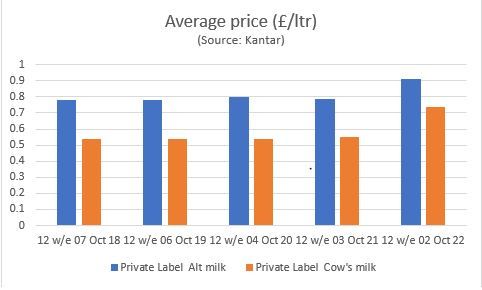All food groups have been hit hard by inflation. The ONS says that prices for food and drinks that don’t contain alcohol went up by 14.6% in the year leading up to September 2022. This forces people to rethink some of the things they buy in order to save money. Dairy products have been used as loss-leaders to get people into supermarkets for a long time. This means that the price of milk has been kept artificially low and hasn’t changed much over time. Kantar says that the average price of a litre of own-brand cow’s milk was £0.54 in the 12 weeks ending on October 7, 2018, and £0.55 in the 12 weeks ending on October 2, 2021. Milk has been portrayed as a high-volume, low-margin, highly commoditized category.
Cow’s milk is still a favourite in British homes, and the markets for other milks are very different. If you look back 12 weeks (until September 4, 2022), 95% of homes bought cow’s milk. Compared to this, only 13% of households buy an alternative that is made by a private label, and 22% buy ANY alternative. In fact, less than 6% of the market for milk and alternatives is made up of alternatives.
Cow’s milk is a natural source of protein, calcium, iodine, and vitamin B12. It is also one of the cheapest ways to make sure you are getting good nutrition. During a crisis in the cost of living, it makes sense that people would look for the best value for their money. Cow’s milk is the best value out there. Cow’s milk is 23% cheaper than the alternatives (Kantar 12we 2 Oct 2021), so most people, except those with food allergies or special dietary needs, will probably continue to buy it. There is a chance that people will try to waste less milk and plan how much they drink better, which could cause some volume loss.
The price of private label cow’s milk has gone up.
The price of private label cow’s milk went up by 35% from £0.55pl to £0.74pl in one year.

There is no better value for money than cow’s milk.
1
Have the prices of alternatives to milk also gone up?
The price of private label alternatives has also gone up by 15%, to an average of £0.91 per litre. This still costs 23% more than cow’s milk with a private label. Branded alternatives, which make up 2/3 of the value of the alternative market, have gone up in price by only 8%, but since they already cost £1.59 per litre, people who buy alternatives have been switching to cheaper private label alternatives. The branded alternative market has lost 10% of its volume from one year to the next, while the private label alternative market has gained 10% of its volume.
The alternative milk market is going through the same process of becoming a commodity as cow’s milk did many years ago, when supermarkets started selling milk and bread at low prices as a loss-leader to bring in customers. This includes a shift from brand names to private labels. The cost of living crisis is likely to keep putting pressure on the alternative sector, which will put pressure on margins in the future.
Why are the prices of cow’s milk going up?
The rising cost of making milk is part of the reason why milk prices are going up in stores. Prices for things like animal feed, fuel, electricity, and fertiliser have gone up a lot, which is a big problem for dairy farms.
Defra’s agricultural price index shows that the average cost of farm inputs has gone up by 31% in the 12 months leading up to August. Feed, fuels (energy), and fertiliser are the most important things for dairy farms, and their prices have gone up by 31%, 58%, and 118%, respectively.
The production levels started to go down in the fall of 2021. This was because the costs of making things were going up, there was a constant lack of workers, and farm margins were tight. In the second half of 2021, 138 million litres less milk was delivered than in the same time the year before. This was a 2.3% drop.
Dairy processors raised the prices they paid farmers for milk to help make up for rising costs and to try to get farmers to produce more milk, but deliveries stayed low. But because of how strong and long-lasting price increases were, especially for energy-related inputs like fertiliser and fuel, the price increases did not lead to the increase in milk production that was hoped for.

At the processing level, manufacturers have had to renegotiate selling prices because of the higher cost of getting the milk supplies they need and the rising cost of energy, packaging, labour, and transportation. Prices for fresh milk had been stable for a long time before these increases. Up until last fall (Sep21), real prices for fresh milk were going down because general inflation (as measured by the RPI for all goods) was almost twice as fast as inflation in fresh milk prices.
Conclusion
As long as the price of things like energy and feed keeps going up, it’s likely that the price of things like milk will go up, too, because these costs have to be passed on to the customer. But rising prices aren’t just happening with dairy milk; prices are also going up for alternatives. Cow’s milk is likely to keep its market share as long as it is a better value for the money, but there could be volume pressures if consumers have to cut back on everything.
[1] Between January 2017 and September 2017, the RPI went up by 16.2%, but the price of fresh milk only went up by 8.4%.









